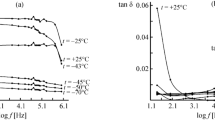Summary
-
1.
The breakdown resistance of all liquid dielectrics is independent of the amount of dissolved water but is dependent on the quantity of emulsified and microemulsified water.
-
2.
Changes in the diameter of the emulsified water droplets in liquid dielectrics within the range of 0.5 to 50 μ has no effect on dielectric strength of the dielectrics.
-
3.
Secondary processes in a series of other processes have a relatively minor effect on the reduction in dielectric strength of liquid dielectrics (for crude oil containing 0.3% water, this effect does not exceed 10% of the total); as the water content is increased, the effect of secondary processes in reducing the dielectric strength becomes more important.
-
4.
For aqueous emulsions of organic liquids, there is a limit depending on water content that governs whether they can be regarded as liquid dielectrics or as conductors of the second type; for crude oils, this limit corresponds to a water content of about 1%.
-
5.
The theories of Hemant and Boning do not reflect the physical significance of the breakdown process of liquid dielectrics containing water and hence cannot be regarded as correct.
-
6.
The breakdown of pure liquid dielectrics, as is evident from the results of our investigations, can be explained by the gas theory of shock ionization in the bulk.
-
7.
The results obtained from these studies can be used in controlling and monitoring the process of crude oil dehydration and desalting, in the design of instruments to determine the amount of emulsified water in crude oil, and in the design of electrodehydrators and development of an automatic control system for operation of such equipment [11, 12].
Similar content being viewed by others
Literature cited
G. I. Skanavi, Physics of Dielectrics, Domain of Strong Fields [in Russian], Fizmatgiz (1958).
I. E. Balygin, Dielectric Strength of Liquid Dielectrics [in Russian], Izd. Énergiya (1964).
Ch. M. Dzhuvarly, K. I. Ivanov, M. V. Kurlin, R. A. Lipshtein, and L. A. Mukharskaya, Electric Insulating Oils [in Russian], Gostoptekhizdat (1963).
J. A. Kok, Electrical Breakdown of Insulating liquids (Einhoven), Philips (1961).
A. M. Lazarev, Effect of Type of Water Distribution on Dielectric Strength of Liquid Dielectrics, ZhTF, Vol. 4, No. 5 (1934).
R. A. Lipshtein and E. N. Shtern, Development of Theory of Breakdown of Commercial Liquid Dielectrics, Élektrotekhnika, No. 3 (1964).
V. G. Ben'kovskii, Dispersion in an Electric Field, Kolloid. Zhurn., Vol. 16, No. 1 (1953).
E. T. Z., Ausgabe A, 79831, No. T-9 (1962).
E. T. Z., Ausgabe A, 4 (1963).
B. I. Brounshtein, High-Frequency Method for Electric Dehydration of Crude Oils [in Russian], Dissertation, I. M. Gubkin Moscow Petroleum Institute.
A. A. Spirin and Ya. M. Frankfurt, Effect of Electrical Properties of Crude Oils on Efficiency of Electrodehydration and Electrodesalting Process, Neft i Gaz, No. 11 (1965).
Ya. M. Frankfurt, Method of Quantitative Determination of Water Content of Liquid Dielectrics, for Example, Crude Oil, Author's Certificate (USSR Pat.) No. 158,444, Byull. Izobr., No. 21 (1963).
Author information
Authors and Affiliations
Additional information
Translated from Khimiya i Tekhnologiya Topliv i Masel, No. 12, pp. 46–50, December, 1966.
Rights and permissions
About this article
Cite this article
Kurlin, M.V., Spirin, A.A. & Frankfurt, Y.M. Dielectric strength and electric conductivity of liquid dielectrics containing water. Chem Technol Fuels Oils 2, 868–871 (1966). https://doi.org/10.1007/BF00731542
Issue Date:
DOI: https://doi.org/10.1007/BF00731542




